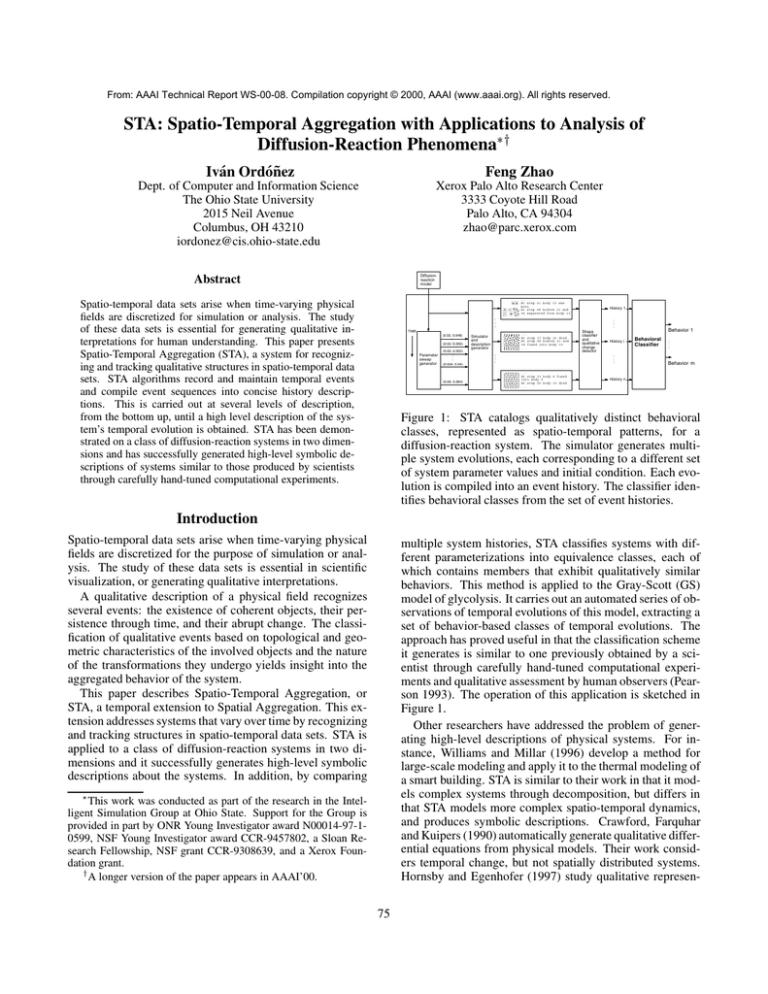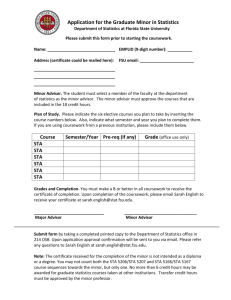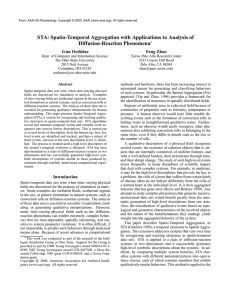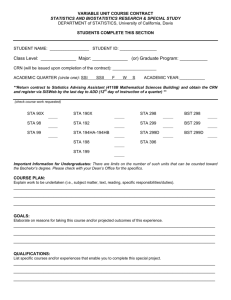
From: AAAI Technical Report WS-00-08. Compilation copyright © 2000, AAAI (www.aaai.org). All rights reserved.
STA: Spatio-Temporal Aggregation with Applications to Analysis of
Diffusion-Reaction Phenomenay
Iván Ordóñez
Feng Zhao
Dept. of Computer and Information Science
The Ohio State University
2015 Neil Avenue
Columbus, OH 43210
iordonez@cis.ohio-state.edu
Xerox Palo Alto Research Center
3333 Coyote Hill Road
Palo Alto, CA 94304
zhao@parc.xerox.com
Diffusionreaction
model
Abstract
Spatio-temporal data sets arise when time-varying physical
fields are discretized for simulation or analysis. The study
of these data sets is essential for generating qualitative interpretations for human understanding. This paper presents
Spatio-Temporal Aggregation (STA), a system for recognizing and tracking qualitative structures in spatio-temporal data
sets. STA algorithms record and maintain temporal events
and compile event sequences into concise history descriptions. This is carried out at several levels of description,
from the bottom up, until a high level description of the system’s temporal evolution is obtained. STA has been demonstrated on a class of diffusion-reaction systems in two dimensions and has successfully generated high-level symbolic descriptions of systems similar to those produced by scientists
through carefully hand-tuned computational experiments.
:
:
:
...
At step 21 body 13 was
born
At step 48 bodies 21 and
34 separated from body 13
...
:
:
:
TIME
(0.02, 0.048)
:
(0.02,: 0.050)
Parameter
sweep
generator
(0.02, :0.052)
:
:
(0.024, 0.04)
(0.06, 0.064)
...
At step 17 body 21 died
At step 48 bodies 21 and
34 fused into body 19
...
Simulator
and
description
generator
History 1
:
:
:
Shape
classifier
and
qualitative
change
detector
History i
:
:
:
...
At step 33 body 8 fused
into body 9
At step 55 body 10 died
...
Behavior 1
Behavioral
Classifier
:
:
:
Behavior m
History n
Figure 1: STA catalogs qualitatively distinct behavioral
classes, represented as spatio-temporal patterns, for a
diffusion-reaction system. The simulator generates multiple system evolutions, each corresponding to a different set
of system parameter values and initial condition. Each evolution is compiled into an event history. The classifier identifies behavioral classes from the set of event histories.
Introduction
Spatio-temporal data sets arise when time-varying physical
fields are discretized for the purpose of simulation or analysis. The study of these data sets is essential in scientific
visualization, or generating qualitative interpretations.
A qualitative description of a physical field recognizes
several events: the existence of coherent objects, their persistence through time, and their abrupt change. The classification of qualitative events based on topological and geometric characteristics of the involved objects and the nature
of the transformations they undergo yields insight into the
aggregated behavior of the system.
This paper describes Spatio-Temporal Aggregation, or
STA, a temporal extension to Spatial Aggregation. This extension addresses systems that vary over time by recognizing
and tracking structures in spatio-temporal data sets. STA is
applied to a class of diffusion-reaction systems in two dimensions and it successfully generates high-level symbolic
descriptions about the systems. In addition, by comparing
multiple system histories, STA classifies systems with different parameterizations into equivalence classes, each of
which contains members that exhibit qualitatively similar
behaviors. This method is applied to the Gray-Scott (GS)
model of glycolysis. It carries out an automated series of observations of temporal evolutions of this model, extracting a
set of behavior-based classes of temporal evolutions. The
approach has proved useful in that the classification scheme
it generates is similar to one previously obtained by a scientist through carefully hand-tuned computational experiments and qualitative assessment by human observers (Pearson 1993). The operation of this application is sketched in
Figure 1.
Other researchers have addressed the problem of generating high-level descriptions of physical systems. For instance, Williams and Millar (1996) develop a method for
large-scale modeling and apply it to the thermal modeling of
a smart building. STA is similar to their work in that it models complex systems through decomposition, but differs in
that STA models more complex spatio-temporal dynamics,
and produces symbolic descriptions. Crawford, Farquhar
and Kuipers (1990) automatically generate qualitative differential equations from physical models. Their work considers temporal change, but not spatially distributed systems.
Hornsby and Egenhofer (1997) study qualitative represen-
This work was conducted as part of the research in the Intelligent Simulation Group at Ohio State. Support for the Group is
provided in part by ONR Young Investigator award N00014-97-10599, NSF Young Investigator award CCR-9457802, a Sloan Research Fellowship, NSF grant CCR-9308639, and a Xerox Foundation grant.
y A longer version of the paper appears in AAAI’00.
75
tations of change, such as an object’s continuation, separation and fusion, and construct hierarchies of change, but
they do not attempt to apply these objects to continuous
fields. Forbus, Nielsen and Faltings (1991) developed the
CLOCK project, which uses qualitative spatial reasoning to
automatically analyze and qualitatively predict the behavior
of fixed-axis mechanisms, such as mechanical clocks. Their
approach is suitable for mechanical systems of rigid parts,
while ours is best suited for continuous fields that exhibit
high-level properties such as quasi-uniform regions.
The main contribution of this paper is a computational
system that analyzes very large sets of unstructured data to
produce descriptions of qualitatively distinct aggregate objects and events.
DR
Parameters
DR Model
DR Numerical
Integrator
Particle
System
Parameters
Field
Initializer
DR Field
Particle
System
Updater
Field Simulation
Particle
System
Initializer
Particle
System
Particle System Engine
Aggregator
Neighborhood
Graph Updater
Neighborhood
Graph
Aggregation
Classifier
Classification
Spatio-Temporal Aggregation
STA significantly extends the functionality of Spatial Aggregation (SA) in the temporal dimension. SA provides a uniform vocabulary and mechanism for representing and reasoning about spatial fields. For a full description of the SA
field ontology and operators see Yip and Zhao (1996) and
Bailey-Kellogg (1999).
Existing applications of SA abstract over domains such as
phase spaces and configuration spaces, in which time is only
implicitly represented. Others deal with physical spaces in
a fixed, steady state. In all these cases the field, as an ontology, and all the conceptual layers built on top of it, are static.
Problems that use time are not necessarily outside the domain of Spatial Aggregation. For example, KAM (Yip 1989)
is used to study Hamiltonian systems, which describe frictionless motion. These systems are studied in phase space,
where temporal variation is implicitly represented. More in
general, SA could be used to study time-varying systems as
simple static systems where time has been represented as
an extra spatial dimension. On the other hand, STA offers,
beyond such approaches, the ability to reason about timevarying systems without having to compute and store the
entire space-time volume beforehand.
Sophisticated techniques have been developed to address
the problem of temporal tracking in fields (Silver and Wang
1997). It seems natural to find whether there is a generalization of these tracking approaches, which would let them
deal with not just one, but multiple abstraction layers.
The main addition made to the SA standard vocabulary by
STA is the update operator, which takes a field or an object
space and applies a set of transformations corresponding to
the passage of a time interval.
Class
Updater
Particle
Classes
Polygonal
Aggregate
Updater
Redescriptor
Polygonal
Aggregates
Other Histories
Redescription
Shape
Detector &
Classifier
Qualitative
Change
Detector
Shape
Space
Shape Space Aggregation
History
History
Aggregator
and
Classifier
Behavioral
Classes
Figure 2: STA application to the analysis of diffusionreaction systems. A field simulator generates system evolutions, which are tracked by the particle system. A chain of
aggregation, classification and re-description is maintained
to track high-level objects. Qualitative changes are registered into event histories. The history aggregator and classifier take multiple histories and identify behavioral classes.
Updates on Re-described Objects: Changes in classes of
objects may affect the way higher-level objects are redescribed, depending on what features are kept in the redescription process and which are abstracted away.
Kinetic Data Structures: Reasoning about
Change Detection
STA employs ideas from Kinetic Data Structures (KDS)
to maintain the consistency of neighborhood graphs, object
classes and re-described objects. KDS have been developed
in robotics to maintain a set of geometric relations among
distributed data (Basch, Guibas and Hershberg 1997). The
problem KDS address consists of determining under which
conditions the structure of certain geometric constructs is altered given that the elements are subject to particular motion
laws.
Updates on Neighborhood Graphs: For a set of objects S,
a neighborhood graph is a relation R 2 S S . When objects in space come into existence, cease to exist or change
positions, their adjacencies may be modified.
Updates on Object Classes: Changes in adjacencies may
cause objects to cease to belong to a certain class or to
start belonging to a new class. Classes are connected sets
of objects; therefore, changes in R may affect classes.
Also, changes in the intrinsic properties of the objects
may also affect the way they are classified.
Update Mechanisms
We enhance the static SA to include certificate-violation
based update mechanisms adapted from KDS. This is done
first at the neighborhood graph level, by associating the
graph (namely, its vertices and its adjacencies) with a set of
76
certificates that establish how much deformation the graph
can take without undergoing a structural change. The classifier operator now does not only map objects to classes via
the neighborhood graph, but it also maps graph changes due
to certificate violations to class changes.
Application to Diffusion-Reaction Systems
Figure 3: Subdivision generated from a particle system that
samples a diffusion-reaction system
We present a structure-identification algorithm for describing and classifying instances of diffusion-reaction systems
that exhibit highly organized spatio-temporal structure. Figure 2 illustrates the operation of the algorithm.
Tracking High-Level Structures
The existence of coherent structures in a field implies that
there are regions of approximately uniform characteristics.
Once those regions are identified, characteristics such as
topology and temporal behavior can be studied. The Field
Simulation module (see Figure 2) generates the field and its
changes, but is unaware of the existence of high-level structures.
Diffusion-reaction fields are sampled by the STA algorithm using particle systems (see corresponding block in
Figure 2). Particles have the advantage of being persistent:
they have discrete identities and hence whatever happens to
them can be tracked in time with ease.
We use a simple algorithm that allows the particle system
to adapt itself to changes in the field, always maintaining
an adequate sampling. The algorithm is a modification of
a method introduced by Witkin and Heckbert (1994). It allows particles to move across the field, repelling each other,
thereby occupying space uniformly. Moreover, they modify their distribution and density to compensate for under or
over-sampling.
The sampling particles are used to construct a spatial subdivision. The subdivision is computed by dividing the space
into simplices whose vertices are the particles, and whose
edges constitute a neighborhood relation for the particles.
The simplices need to be small and non-sharp, so a Delaunay triangulation is used.
As the field varies in time, so does the position of the particles. This, in turn, causes the spatial subdivision to change:
some edges cease to exist and some new ones arise at every
time step. However, given the assumption that the underlying field changes slowly, the vast majority of edges and
triangles are preserved through successive time steps, even
though their shape is slightly changed.
The static construction of a neighborhood graph constitutes the aggregation operator in SA. The corresponding
block in Figure 2 represents the enhanced STA aggregate
operation, which maintains the neighborhood graph as the
particle system changes.
Cluster boundaries are associated with field regions of
high gradient. Those regions are identified using iso-lines,
continuous zones of uniform or near-uniform field value.
The particle placement algorithm previously described is
used to approximate iso-line contours of uniform regions.
This algorithm requires the ability to determine class equivalence between particles (the classification block in Figure 2).
Figure 4: Successive snapshots of the evolution of a GrayScott diffusion-reaction system
The extraction of structures from the spatial subdivision is
analogous to a pixel-based region growing algorithm, with
the difference that the element of aggregation is not the
pixel, but the sampling particle. The block that does this
is labeled redescription. In Figure 3 the result of carrying
out this process is exemplified.
STA records not only catastrophic events (such as object
collisions), but also events that involve a single object modifying its shape. We use a shape-recognition and classification method called the Multiple Curvature Segmentation
Algorithm, introduced by Dudek and Tsotsos (1997). Objects are placed in a shape space, and they are clustered by
similarity. See the Shape Space Aggregation block in Figure 2.
Extracting Behavioral Descriptions
The STA algorithmic components we have described so far
take as input a time-evolving diffusion-reaction system and
produce the following descriptions:
A detailed history of qualitatively significant events, including births, deaths, collisions and fusions of objects,
and their changes in shape, and
A summary of significant events that have taken place in
the history.
The last two blocks of Figure 2 indicate the final summarization process of the STA application: multiple histories as
At step 88 body 3 was born
At step 88 body 2 was born
At step 88 body 1 was born
At step 88 body 0 was born
At step 229 bodies 0 (born 88), 3 (born 88) fused into body 1
At step 237 body 2 (born 88) fused into body 1
Table 1: A segment of a history: each entry is a timestamped event. Notice that two fusion events are recorded.
In them, the larger object preserves its identity, and the
smaller ones are said to have fused to it.
77
do if applied outside of this domain? We expect that a
straightforward application of STA to problems that require
extensive contextual and non-geometric knowledge would
not work as well. For example, tracking objects for computer vision requires solving problems such as that of object occlusion and representation from incomplete information, not to mention the existence of multiple perspectives,
different levels of illumination and reflectance, etc. In order to address those problems, STA needs to integrate additional domain specific techniques from computer vision.
Similarly, the problem of examining weather patterns also
requires extensive domain knowledge. While this problem
seems more amenable to treatment from a STA perspective,
it would still require integrating specific techniques such as
those developed by Huang and Zhao (2000) with the STA
tracking mechanism.
Figure 5: Snapshots for DR system evolutions
Cluster 1:
History (h)
Cluster 2:
Histories (e) and (g)
Cluster 3:
History (b)
Cluster 4:
Histories (c), (d) and (f)
Cluster 5:
History (a)
Table 2: Behavioral classes discovered by STA
References
generated above are compared, and then classified according
to behavioral similarity.
Bailey-Kellogg, C. 1999. The Spatial Aggregation Language for Modeling and Controlling Distributed Physical
Systems. Ph.D. diss., Dept. of Computer and Information
Science, The Ohio State Univ.
Basch, J.; Guibas, L.; and Hershberg, J. 1997. Data Structures for Mobile Data. In Proceedings of the 8th ACM-SIAM
Symposium on Discrete Algorithms 747–756.
Crawford, J; Farquhar, A.; and Kuipers, B. 1990. QPC: A
Compiler from Physical Models into Qualitative Differential
Equations. In Proceedings of the National Conference on
Artificial Intelligence (AAAI-90), AAAI/MIT Press.
Dudek, G. and Tsotsos, J. 1997. Shape Representation and
Recognition from Multiscale Curvature. Computer Vision
and Image Understanding 68(2): 170–189.
Forbus, K.; Nielsen, P.; and Faltings, B. 1991. Qualitative
Spatial Reasoning: The Clock Project. Artificial Intelligence
51(1–3): 417–471.
Hornsby, K. and Egenhofer, M. 1997. Qualitative Representation of Change. In Proceedings of the International Conference on Spatial Information Theory (COSIT-97), Lecture
Notes in Computer Science, 1329:15–33.
Huang, X. and Zhao, F. 2000. Relation-Based Aggregation:
Finding Objects in Large Spatial Datasets. Inter. J. of Intelligent Data Analysis. To appear.
Pearson, J. 1993. Complex Patterns in a Simple System.
Science, 261.
Silver, D. and Wang, X. 1997. Tracking and Visualizing
Turbulent 3D Features. IEEE Transactions on Visualization
and Computer Graphics 3:129–141.
Williams, B. C. and Millar, B 1996. Automated Decomposition of Model-based Learning Problems. In Proceedings of
QR-96.
Witkin, A. and Heckbert, P. 1994. Using Particles to Sample and Control Implicit Surfaces. In Computer Graphics,
SIGGRAPH 94 Proceedings.
Yip, K. 1989. KAM: Automatic Planning and Interpretation of Numerical Experiments using Geometrical Methods.
Ph.D. diss., Massachusetts Institute of Technology.
Yip, K. and Zhao, F. 1996. Spatial Aggregation: Theory and
Applications. Journal of Artificial Intelligence Research, 5.
A Sample Session
We now present a short run of the history-generation part
of the program. It records the events that take place in an
evolving diffusion-reaction field. For instance, when a system such as that shown in Figure 4 evolves, the program can
generate a history file such as that of Table 1.
The program can also compare several histories and group
them into classes of similar behavior. For the systems on
Figure 5, the groups in Table 2 were discovered. Compare
these with the classes discovered by Pearson (1993), shown
in Figure 6: cluster 4 corresponds to pattern (b); cluster 2 to
(c) and cluster (5) to (a).
Conclusions
This paper has described a novel computational system,
STA, for reasoning about time-varying fields such as
diffusion-reaction systems. STA extends Spatial Aggregation to make explicit the representation of time and temporal
change.
STA has been demonstrated on a complex dynamical system that exhibits multiple, qualitatively different behaviors.
This demonstration accounts for approximately 83% of the
observations meticulously carried out by Pearson as documented in his 1993 paper. What this research contributes
that had not been done before is the automatic differentiation of pattern classes by behavior.
STA makes use of various techniques, namely, operations
of abstraction of change, kinetic data structures and geometric shape classification. How well would these techniques
Figure 6: Patterns discovered by Pearson (1993) on the
Gray-Scott system
78




